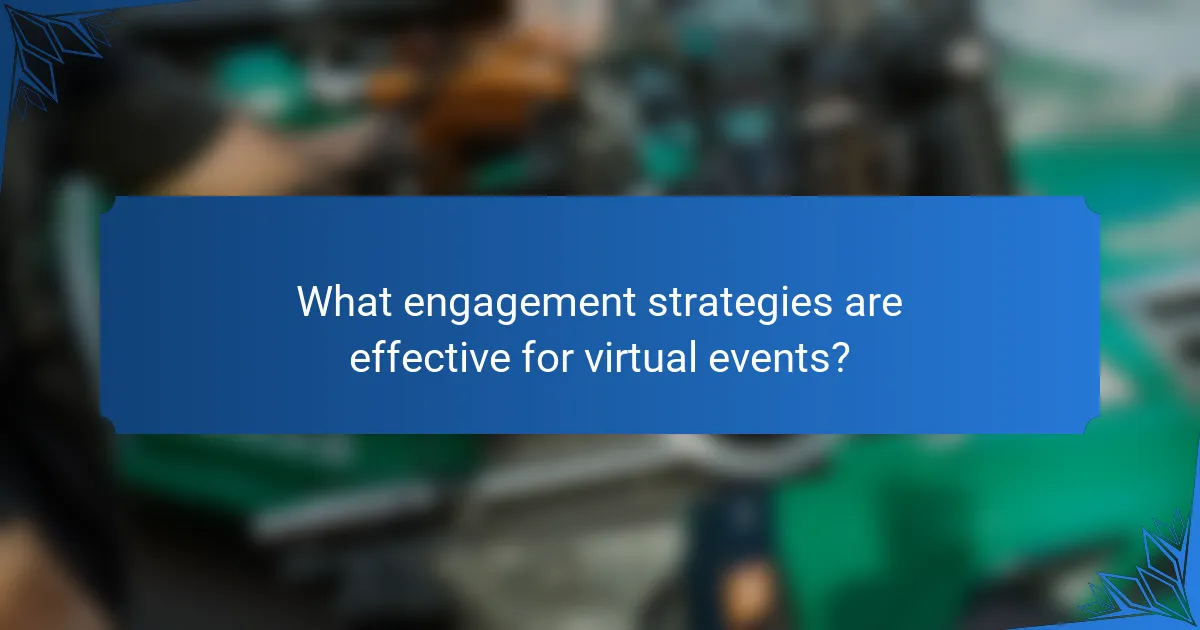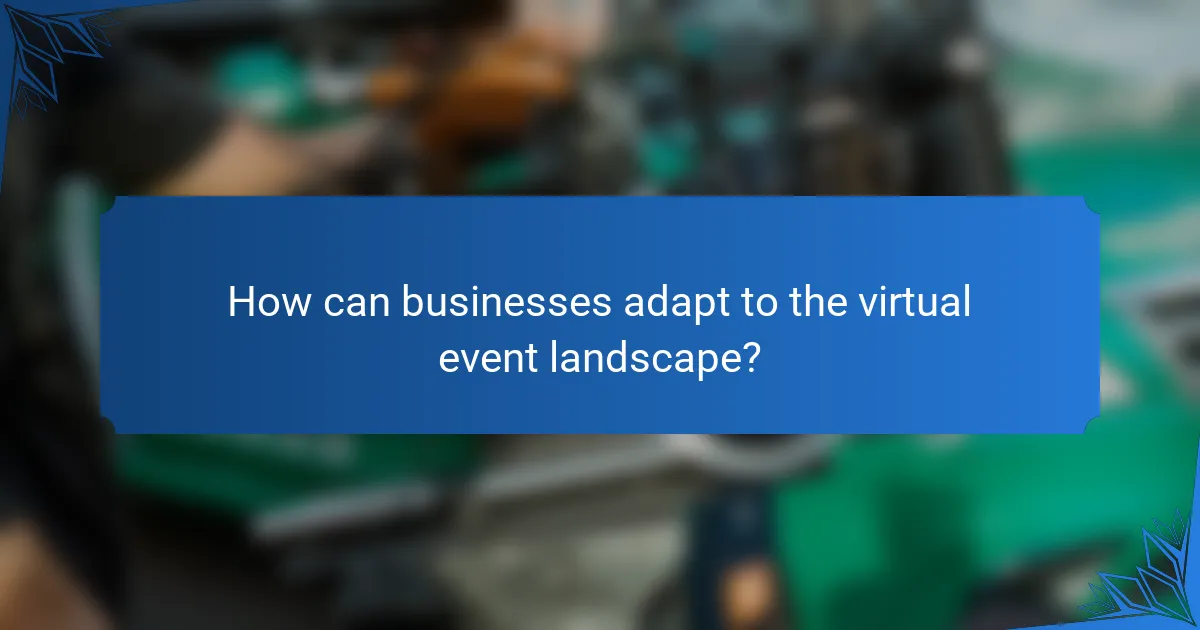Virtual events have transformed the landscape of audience engagement by eliminating geographical barriers and enabling participation from a diverse range of locations. By utilizing digital platforms, organizers can not only reach larger audiences but also implement interactive strategies that foster connection and participation. To thrive in this new environment, businesses must adapt by embracing technology and developing hybrid models that blend in-person and online experiences.

How can virtual events enhance audience reach in the UK?
Virtual events can significantly enhance audience reach in the UK by breaking geographical barriers and allowing participation from diverse locations. By leveraging digital platforms, organizers can attract larger audiences than traditional in-person events.
Utilizing social media platforms
Social media platforms like Facebook, Twitter, and LinkedIn are essential for promoting virtual events. Creating event pages and sharing engaging content can attract attention and encourage sharing among users, expanding your reach.
Consider using targeted ads to reach specific demographics, which can increase visibility among potential attendees. Regular updates and interactive posts can maintain interest and drive engagement leading up to the event.
Leveraging email marketing campaigns
Email marketing remains a powerful tool for reaching audiences. Crafting personalized invitations and reminders can help ensure that your target audience is aware of the event and motivated to attend.
Segment your email list to tailor messages based on interests or past interactions, increasing the likelihood of engagement. Aim for a clear call-to-action in your emails, such as a direct link to register for the event.
Implementing SEO strategies
Search Engine Optimization (SEO) can enhance the visibility of your virtual event. By optimizing your event webpage with relevant keywords, you can improve its ranking on search engines, making it easier for potential attendees to find.
Consider creating valuable content related to your event topic, such as blog posts or videos, to attract organic traffic. Additionally, ensure that your event page is mobile-friendly, as many users will access it via smartphones.

What engagement strategies are effective for virtual events?
Effective engagement strategies for virtual events include interactive elements that foster participation and connection among attendees. By incorporating features like polls, gamification, and networking opportunities, organizers can enhance the overall experience and keep participants actively involved.
Interactive polls and Q&A sessions
Interactive polls and Q&A sessions are powerful tools for engaging participants during virtual events. They allow attendees to share their opinions and ask questions in real-time, creating a dynamic atmosphere. Consider using platforms that support instant feedback to gauge audience sentiment and adjust content accordingly.
To maximize effectiveness, keep polls concise and relevant to the topic at hand. Aim for a mix of multiple-choice questions and open-ended queries to encourage diverse responses. Regularly incorporate audience questions into your presentations to maintain engagement and show that their input is valued.
Gamification elements
Gamification elements can significantly enhance engagement by introducing game-like features into virtual events. This can include leaderboards, challenges, and rewards for participation, which motivate attendees to interact more actively. For instance, offering points for answering questions or participating in discussions can create a competitive yet fun environment.
When implementing gamification, ensure that the rules are clear and that rewards are appealing to your audience. Simple prizes, such as gift cards or exclusive content access, can boost participation rates. However, avoid overcomplicating the game mechanics, as this may detract from the main event focus.
Networking opportunities through breakout rooms
Networking opportunities through breakout rooms facilitate meaningful connections among attendees in a virtual setting. By dividing participants into smaller groups, you create a more intimate environment where individuals can engage in discussions and share insights. This approach mimics in-person networking, making it easier for attendees to connect.
To optimize breakout sessions, provide clear guidelines on discussion topics and encourage participants to introduce themselves. Limit the duration of these sessions to keep conversations focused and dynamic, typically around 10-15 minutes. Follow up with a larger group discussion to share key takeaways and maintain the overall event momentum.

How can businesses adapt to the virtual event landscape?
Businesses can adapt to the virtual event landscape by embracing technology, training staff, and developing hybrid models that combine in-person and online experiences. These strategies enhance engagement and broaden reach, ensuring successful events in a digital-first world.
Investing in virtual event technology
Investing in robust virtual event technology is essential for creating engaging online experiences. Key tools include event platforms that support live streaming, interactive features, and analytics to track participant engagement. Budgeting for these technologies typically ranges from a few hundred to several thousand dollars, depending on the scale and complexity of the event.
Consider integrating features like chat rooms, polls, and breakout sessions to foster interaction. Choosing a platform that aligns with your audience’s preferences can significantly enhance the overall experience.
Training staff for virtual facilitation
Training staff for virtual facilitation is crucial to ensure smooth event execution. This includes familiarizing them with the technology, understanding audience engagement techniques, and mastering online communication skills. Workshops or online courses can be effective in equipping team members with the necessary skills.
Encourage practice sessions to build confidence and troubleshoot potential issues. A well-prepared team can significantly improve participant satisfaction and event success.
Creating hybrid event models
Creating hybrid event models allows businesses to cater to both in-person and virtual audiences, maximizing reach and engagement. This approach requires careful planning to ensure a seamless experience for all participants, regardless of how they attend.
Consider logistics such as audio-visual setups that accommodate both audiences, as well as interactive elements that engage remote attendees. Offering flexible ticketing options can also help attract a wider audience, with pricing strategies that reflect the different experiences offered.

What are the key metrics for measuring virtual event success?
Key metrics for measuring virtual event success include attendance rates, participant engagement, and feedback collected post-event. These metrics provide insights into how well the event resonated with the audience and areas for improvement.
Attendance and participation rates
Attendance and participation rates are fundamental indicators of a virtual event’s reach. High attendance suggests effective marketing and interest in the content, while participation rates reflect how engaged attendees are during the event.
To assess these rates, track the number of registered participants versus actual attendees. A good benchmark is to aim for an attendance rate of 50-70% of registered users, depending on the event type.
Engagement levels through interactions
Engagement levels can be measured through various interactions, such as chat activity, Q&A participation, and polls. High engagement indicates that attendees are actively involved and finding value in the content presented.
Consider using tools that track these interactions in real-time. Aim for at least 30% of attendees to participate in interactive elements, which can enhance the overall experience and provide valuable insights into audience interests.
Post-event feedback and surveys
Post-event feedback and surveys are crucial for understanding attendee satisfaction and areas for improvement. Collecting feedback helps gauge the perceived value of the event and informs future planning.
Utilize simple surveys with a mix of quantitative and qualitative questions. Aim for a response rate of at least 20-30% of attendees, and focus on key areas such as content relevance, speaker effectiveness, and overall experience to gather actionable insights.

What are the prerequisites for hosting a successful virtual event?
To host a successful virtual event, you need to ensure you have the right technology, a clear plan, and an understanding of your audience. These prerequisites help create an engaging experience that meets your goals and resonates with participants.
Choosing the right platform
Selecting the appropriate platform is crucial for your virtual event’s success. Consider factors such as user interface, scalability, features, and integration capabilities with other tools. Popular options include Zoom, Microsoft Teams, and Webex, each offering different functionalities tailored to various event types.
Evaluate your audience’s familiarity with the platform to ensure ease of access. For instance, if your participants are primarily corporate professionals, a platform like Microsoft Teams may be more suitable due to its integration with other Microsoft products.
Defining clear objectives
Establishing clear objectives is essential for guiding your virtual event’s planning and execution. Determine what you want to achieve, whether it’s increasing brand awareness, generating leads, or fostering community engagement. Having specific goals helps in measuring success post-event.
Consider using the SMART criteria—Specific, Measurable, Achievable, Relevant, and Time-bound—to refine your objectives. For example, aiming to attract 500 participants and achieve a 70% engagement rate can provide a focused target for your efforts.



